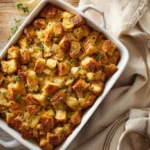Ingredients
- 2-2⅓ cups all-purpose flour OR bread flour divided (250-295g)
- 1 packet instant yeast 2¼ teaspoons
- 1½ teaspoons sugar
- ¾ teaspoon salt
- ⅛-¼ teaspoon garlic powder and/or dried basil leaves optional
- 2 tablespoons olive oil + additional for coating
- ¾ cup warm water 175ml
Instructions
- In a large mixing bowl, whisk together 1 cup (125g) of flour, instant yeast, sugar, and salt. If using, incorporate garlic powder and dried basil at this stage.
- Pour in olive oil and warm water, then stir thoroughly with a wooden spoon until well combined.
- Slowly incorporate another 1 cup (125g) of flour. Continue adding flour as necessary (up to an additional ⅓ cup may be needed), mixing until the dough forms a cohesive, stretchy ball that starts pulling away from the bowl sides. The dough should be slightly tacky but workable by hand.
- Generously coat a separate large, clean bowl with olive oil, using a pastry brush to coat the sides thoroughly.
- Lightly flour your hands and shape the pizza dough into a round ball. Place in the oil-coated bowl and roll the dough around to coat all surfaces with oil. Cover tightly with plastic wrap and set in a warm location.
- Let the dough rise for 30 minutes or until it doubles in size. If planning to bake immediately, preheat oven to 425°F (215°C) during this time.
- After rising, gently punch down the dough and move to a lightly floured work surface. Knead briefly until smooth (approximately 3-5 kneads).
- Using your hands or a rolling pin, stretch and shape the dough into a 12-inch circle.
- Move the shaped dough to a parchment-lined pizza pan and create a crust by pinching or folding the edges.
- Drizzle about 1 tablespoon of olive oil over the pizza surface and brush evenly across the entire dough, including the crust edges.
- Using a fork, pierce holes throughout the center portion of the dough to prevent bubbling during baking.
- Add your preferred toppings and bake in the preheated 425°F (215°C) oven for 13-15 minutes, or until toppings achieve a golden-brown color. Cut into slices and serve immediately.
There’s something truly magical about creating pizza dough from scratch in your own kitchen. The satisfaction of watching simple ingredients transform into the perfect foundation for your favorite pizza is unmatched by any store-bought alternative. This ultimate homemade pizza dough recipe delivers exactly what every pizza lover dreams of: a crust that’s beautifully crispy on the outside while remaining tender and chewy on the inside.
What makes this pizza dough recipe stand out from countless others you’ll find online? It’s the perfect balance of simplicity and technique, requiring just a handful of pantry staples while incorporating professional baking methods that ensure consistent, restaurant-quality results every single time you make it.
Why This Pizza Dough Recipe Works So Well
The secret to exceptional homemade pizza dough lies in understanding the science behind the ingredients and process. This recipe uses instant yeast, which eliminates the guesswork of proofing active dry yeast while providing reliable fermentation. The carefully calculated ratio of flour to liquid creates the ideal hydration level – enough moisture to develop gluten structure without making the dough unworkably sticky.
The addition of olive oil serves multiple purposes beyond flavor enhancement. It creates a tender crumb structure, helps prevent the dough from drying out during the rising process, and contributes to that coveted golden-brown color when baked. The small amount of sugar feeds the yeast for optimal rise while adding a subtle sweetness that balances the overall flavor profile.
Temperature control is crucial for success, and this recipe acknowledges that by specifying the ideal water temperature range of 105-115°F. Water that’s too cool won’t activate the yeast effectively, while water that’s too hot will kill it entirely. The 30-minute rise time at room temperature allows for proper fermentation without over-proofing, which can lead to a dense, tough crust.
The Flour Choice That Makes All the Difference
One of the most thoughtful aspects of this recipe is the flexibility it offers regarding flour selection. All-purpose flour creates a softer, more tender crust that many home cooks prefer for family-style pizzas. The moderate protein content (typically 10-12%) provides enough gluten development for structure without creating an overly chewy texture.
Bread flour, with its higher protein content (12-14%), develops stronger gluten networks that result in a chewier texture and slightly crispier exterior. This choice is excellent for those who prefer a more artisanal, pizzeria-style crust. The recipe’s flexibility allows you to experiment with both options to discover your personal preference.
The graduated flour addition technique – starting with one cup and gradually incorporating more – is a professional baker’s approach that prevents the common mistake of adding too much flour at once. This method allows you to achieve the perfect consistency by feel, accounting for variables like humidity and flour brand variations that can affect absorption rates.
Mastering the Rise and Shaping Process
The oil-coating technique for the rising bowl isn’t just about preventing sticking – it’s about creating an environment that promotes even fermentation while keeping the dough surface from forming a skin. This detail, often overlooked in simpler recipes, makes a significant difference in the final texture.
The gentle deflation and brief kneading after rising redistributes the yeast and evens out the dough structure without overworking it. This step is crucial for achieving uniform texture throughout the finished crust. Many home bakers skip this step, resulting in uneven bubbles and inconsistent texture.
The shaping process offers flexibility – whether you prefer hand-stretching for a more rustic appearance or rolling pin method for perfect uniformity. The key is working the dough while it’s at the right temperature and consistency, neither too warm and sticky nor too cold and resistant.
Professional Finishing Techniques
The final olive oil brush and fork-pricking steps might seem minor, but they’re essential for professional results. The oil creates a barrier that prevents toppings from making the crust soggy while promoting even browning. It also adds richness and helps seasonings adhere to the surface.
Pricking the dough with a fork prevents large air bubbles from forming during baking, which can create uneven surfaces and make topping distribution difficult. This technique, borrowed from professional pizzaiolos, ensures a flat, even base for your toppings.
The specified baking temperature of 425°F strikes the perfect balance for home ovens. It’s hot enough to create proper crust development and browning without being so extreme that it burns the edges before the center cooks through.
Versatility and Make-Ahead Convenience
This recipe’s make-ahead capabilities make it incredibly practical for busy households. The dough can be prepared up to several days in advance and refrigerated, or even frozen for up to a month. This flexibility means you can always have homemade pizza dough ready when inspiration strikes or unexpected guests arrive.
The slow fermentation that occurs during refrigerated storage actually improves flavor development, creating more complex, nuanced taste than dough used immediately. This extended fermentation process breaks down proteins and starches, contributing to better digestibility and enhanced flavor.
The recipe’s generous yield of 12 servings makes it perfect for families or entertaining, while the clear scaling instructions allow you to adjust quantities based on your needs. Whether you’re making pizza for two or hosting a pizza party, this recipe adapts beautifully.
Troubleshooting Common Issues
Even the best recipes can present challenges for home bakers, and this formula addresses common pitfalls proactively. The variable flour amounts account for differences in humidity, flour brands, and measuring techniques that can affect dough consistency. The visual and textural cues provided help bakers recognize when their dough has reached the proper development stage.
The recipe’s emphasis on water temperature prevents the most common yeast-related failures, while the rising time guidelines help prevent both under- and over-proofed dough. These details reflect the recipe developer’s understanding of real-world baking challenges and solutions.
Beyond Basic Pizza Applications
While this recipe excels for traditional pizza, its versatility extends to numerous other applications. The dough works beautifully for focaccia, breadsticks, calzones, or even rolled and cut into dinner rolls. This flexibility makes it an invaluable addition to any home baker’s repertoire.
The balanced flavor profile means it pairs well with both classic Italian toppings and creative fusion combinations. Whether you’re making a simple margherita pizza or experimenting with barbecue chicken and pineapple, this dough provides the perfect neutral canvas for your creativity.
The recipe’s reliability makes it an excellent choice for involving children in cooking projects. The forgiving nature of the dough and clear, step-by-step instructions create opportunities for teaching basic baking skills while creating lasting memories around food preparation.
Mastering homemade pizza dough opens up a world of culinary possibilities while providing the satisfaction of creating something truly special from basic ingredients. This recipe removes the intimidation factor from yeast baking while delivering consistently excellent results that will have your family and friends convinced you’ve discovered the secret to pizzeria-quality crust right in your own kitchen.




